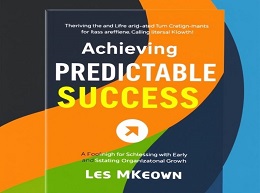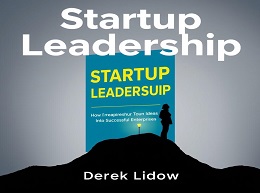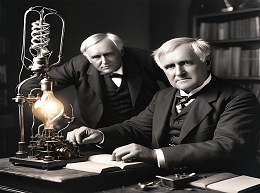Predictable Success: Getting Your Organization on the Growth Track—and Keeping It There

Achieving Predictable Success: A Roadmap for Sustained Organizational Growth
Les McKeown's "Predictable Success: Getting Your Organization on the Growth Track and Keeping It There" is a masterful guide that offers a strategic framework for businesses aiming to achieve and sustain growth. This review delves into the core concepts of the book, highlighting its practical applications, and providing engaging examples that bring the principles to life.
The Lifecycle of an Organization
McKeown presents a compelling model that describes the lifecycle of an organization in seven stages:
1. Early Struggle : The initial phase where survival is the primary focus.
2. Fun : The stage where growth is exciting and the business begins to scale.
3. Whitewater : Growth leads to complexity, requiring new systems and processes.
4. Predictable Success : The organization achieves a balance between flexibility and control, leading to sustainable growth.
5. Treadmill : Overemphasis on processes stifles innovation.
6. The Big Rut : Bureaucracy sets in, and the organization becomes resistant to change.
7. Death Rattle : The final stage where the organization faces decline and closure.
The goal is to achieve and maintain the "Predictable Success" stage, where an organization can grow sustainably without falling into the pitfalls of bureaucracy or chaos.
The Dynamics of Growth
McKeown explains that growth involves balancing two key dynamics: Visionary (V) and Operator (O) styles. Visionaries drive innovation and change, while Operators focus on execution and efficiency. The ideal state, Predictable Success, is achieved when an organization successfully integrates these styles, fostering an environment where creativity and operational excellence coexist.
Principle 1: Embrace Complexity
Amazon's journey from an online bookstore to a global e-commerce giant exemplifies embracing complexity. Jeff Bezos continually expanded Amazon's product lines and services, integrating sophisticated logistics and technology to handle the growing complexity. This strategic embrace of complexity allowed Amazon to maintain its growth trajectory and enter new markets.
Principle 2: Build a Balanced Leadership Team
A balanced leadership team includes Visionaries, Operators, Processors (P), and Synergists (S). Synergists play a crucial role in ensuring that Visionaries, Operators, and Processors work harmoniously.
Example: Google's Leadership
Google’s leadership team is a blend of Visionaries like Larry Page and Sergey Brin, Operators who manage day-to-day operations, and Synergists who foster collaboration. This balance has enabled Google to innovate continuously while efficiently managing its vast operations.
Principle 3: Develop Scalable Systems
As organizations grow, scalable systems and processes become essential. These systems should support, not stifle, innovation.
Example: McDonald's Consistency
McDonald's success is built on its scalable systems that ensure consistency in quality and service across thousands of locations worldwide. These systems have allowed McDonald's to grow predictably while maintaining high standards.
Principle 4: Foster a Culture of Accountability
Accountability ensures that everyone in the organization understands their roles and responsibilities, driving performance and growth.
Example: Toyota's Accountability
Toyota’s culture of accountability, embodied in its Toyota Production System (TPS), has been a cornerstone of its success. By empowering employees to identify and solve problems, Toyota has maintained high quality and efficiency, supporting its growth.
Startups: Navigating Early Struggle and Fun
For startups, the initial focus is on survival and gaining traction. As they transition to the Fun stage, maintaining flexibility while gradually introducing processes is key.
Example: Slack's Transition
Slack started as a small startup offering team communication tools. As it gained popularity, Slack successfully navigated from Early Struggle to Fun by focusing on user feedback and iteratively improving its product. Introducing scalable customer support and onboarding processes helped manage its rapid growth.
SMEs: Managing Whitewater
Small and Medium-sized Enterprises (SMEs) often face the Whitewater stage, where growing complexity requires new systems.
Example: Zappos’ Customer Service Focus
Zappos, an online shoe retailer, managed its transition through Whitewater by prioritizing exceptional customer service. Implementing robust training programs and scalable customer service systems helped Zappos grow while maintaining its unique culture.
Large Enterprises: Sustaining Predictable Success
Large enterprises must focus on sustaining Predictable Success without slipping into Treadmill or Big Rut stages.
Example: Apple's Continuous Innovation
Apple has maintained its growth by continuously innovating while implementing efficient processes. The balance between visionary leadership (Steve Jobs and later Tim Cook) and operational excellence has kept Apple in the Predictable Success stage.
Avoiding the Treadmill
To avoid the Treadmill stage, organizations must ensure that processes do not become overly rigid, stifling innovation.
Example: Netflix's Flexible Culture
Netflix maintains a flexible culture by encouraging employee autonomy and innovation. Its "Freedom and Responsibility" philosophy allows Netflix to adapt quickly to changes, preventing the stifling effects of excessive processes.
Escaping the Big Rut
Organizations in the Big Rut must rekindle their innovative spirit and reduce bureaucratic inertia.
Example: IBM's Reinvention
IBM, once mired in bureaucracy, reinvented itself by shifting focus to new technologies like cloud computing and AI. This strategic pivot, coupled with cultural changes, helped IBM escape the Big Rut and regain its competitive edge.
A Blueprint for Sustainable Growth
"Predictable Success" provides a comprehensive blueprint for achieving and maintaining growth in any organization. Les McKeown's insights into the lifecycle of organizations, the importance of balanced leadership, scalable systems, and a culture of accountability are invaluable for leaders at all levels.













